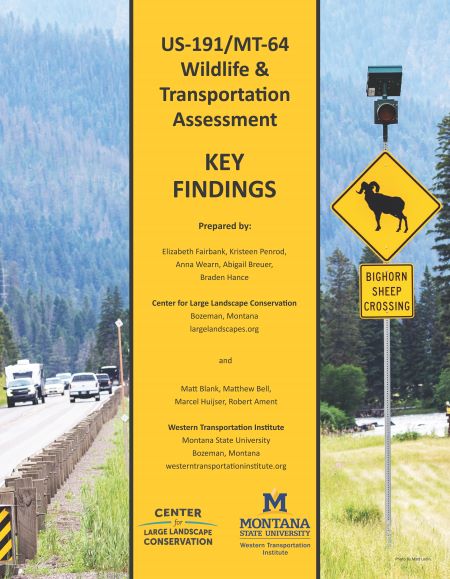Exploring options to improve traveler safety and maintain wildlife movement in a gateway to Yellowstone
Yellowstone National Park’s 2.2 million acres provide critical habitat for the largest concentration of wildlife in the lower 48 states. But this habitat doesn’t stop at the park borders.
Herds of elk, deer and pronghorn move in and out of Yellowstone to access seasonal ranges, and predators like wolves and grizzly bears travel great distances. These species, along with bighorn sheep, wolverines, and others, move throughout the Greater Yellowstone Ecosystem—a richly biodiverse area composed of a patchwork of public and private lands.
However, directly northwest of the park, in Montana, this region is increasingly affected by growing traffic on roads and new subdivisions. As the area’s economy has expanded, so has the number of wildlife-vehicle collisions.
The US-191/MT-64 Wildlife & Transportation Assessment addresses this challenge by improving knowledge of wildlife movement and road safety along roads that connect Yellowstone National Park to the growing Montana population centers of Bozeman and Big Sky.
The Assessment:
- Identifies areas with high levels of wildlife-vehicle collisions and those that are important to maintain wildlife movement
- Informs and supports communities and agencies in decision-making
- Recommends measures to improve road safety as well as habitat connectivity for both land and aquatic species
The Assessment report and Key Findings describe 11 priority sites and recommendations to reduce wildlife-vehicle collisions and reconnect habitat along this gateway to Yellowstone.
The US-191/MT-64 Wildlife & Transportation Assessment was a joint project of the Center for Large Landscape Conservation and Montana State University’s Western Transportation Institute.
For More Information
Full Report: View the full report on the Assessment (164 pages).
Flyer: Read a 2-page description of the Assessment.
Data Portal & ROaDS tool: An accompanying data website allows citizen scientists to record sightings of live and roadkilled animals via a mobile app.
Priority Sites Identified in the Wildlife & Transportation Assessment
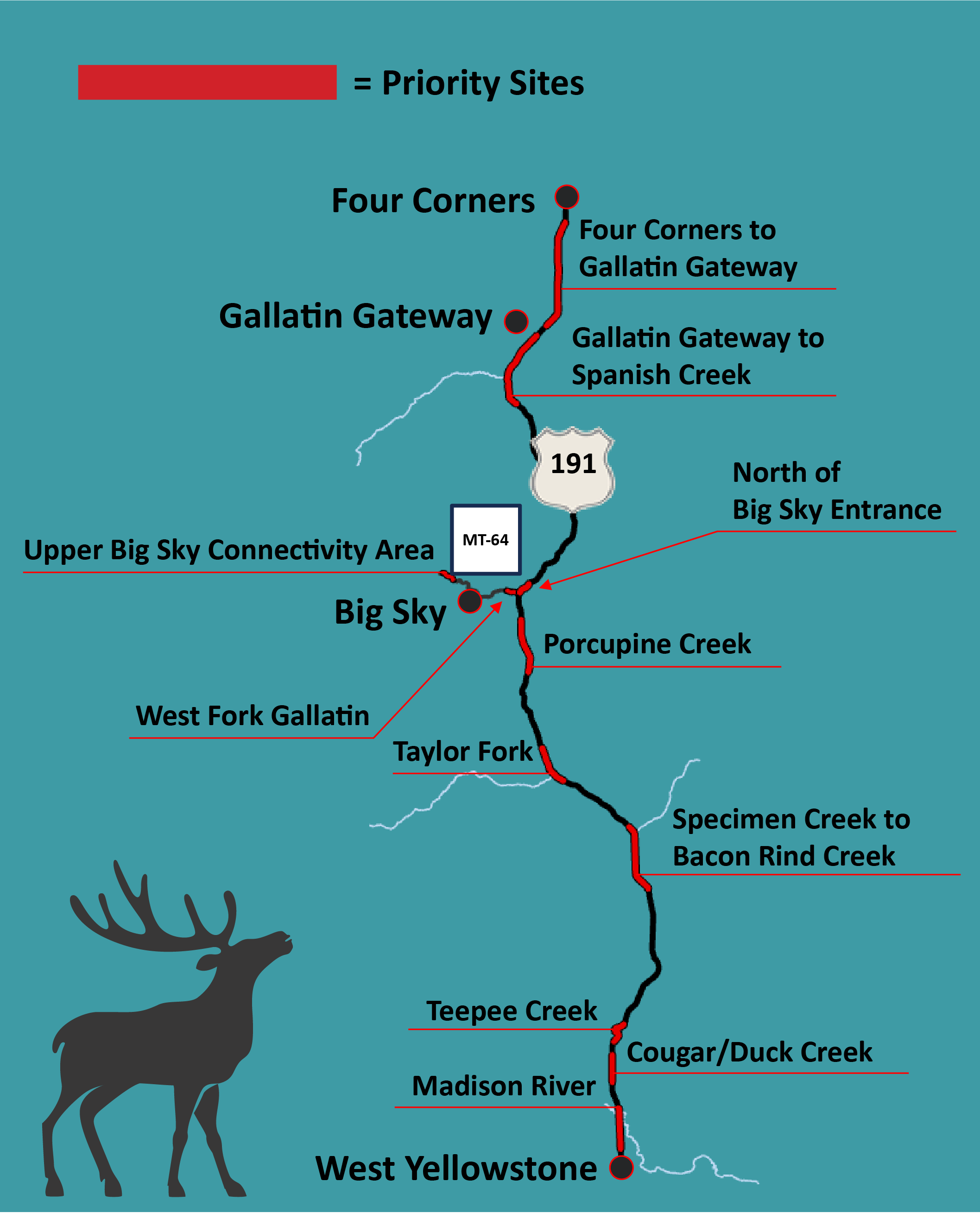
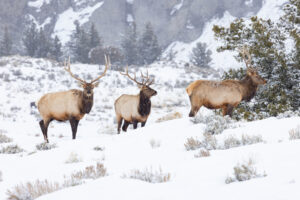
Read More
Read our three-part series of articles in Explore Big Sky newspaper:
Wildlife-vehicle collisions have become common as Gallatin Valley grows
Obstacle course: When a road hinders wildlife movement
Crossing to safety: New possibilities for U.S. Highway 191
Wildlife Crossings: Where Do We Go From Here?
Application-ready
Wildlife crossings at the “mouth of the canyon” (Gallatin Gateway to Spanish Creek priority area)
At present, the Montana Department of Transportation and the Center are awaiting information about federal grant programs, such as the Wildlife Crossings Pilot Program, that may be available to support an application for: a wildlife overpass (see rendering), enlargement of an existing stockpass, and “retrofit” of the large bridge at the mouth of Gallatin Canyon with a path offering secure footing for elk and other ungulates. Located within the top priority site identified in the Wildlife & Transportation Assessment, these structures would be linked by fencing in order to reduce wildlife-vehicle collisions by 80-97%.
The Center has been able to move these crossings to “application ready” status based on years of work in the making supported by area communities and project approval by the Montana Wildlife and Transportation Partnership.
The image below is a conceptual rendering of a wildlife overpass south of Gallatin Gateway. The structure’s final design, location, dimensions, and aesthetic attributes would be determined by the Montana Department of Transportation in a pre-construction design phase.
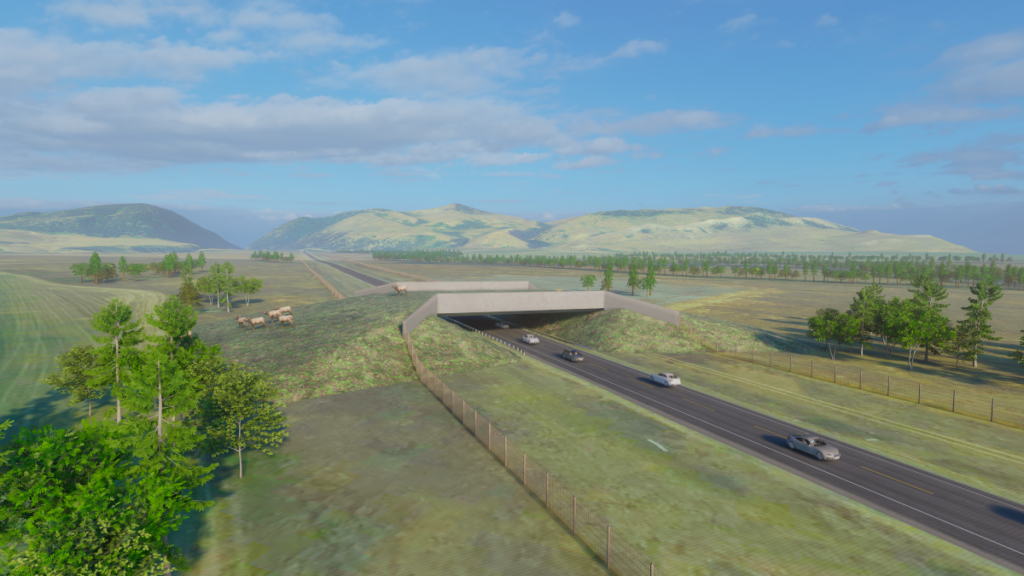
Project Funding
To unlock federal funds that would cover over 80% of project costs, about 20% must be secured by private or other, non-federal funding. Thanks to the bold and inspiring generosity of community organizations, business leaders, and individuals, the Center has made significant strides toward securing the necessary non-federal match for crossings near Gallatin Gateway, and we are grateful to these generous donors (scroll down for a list).
Project Timeline
A wildlife crossing, like any infrastructure project, is a complex process that rarely takes fewer than 5 years from concept to construction. However, they are legacy projects that remain on the ground for an average of 75 years and often pay for themselves in cost savings from reduced wildlife-vehicle collisions much sooner.
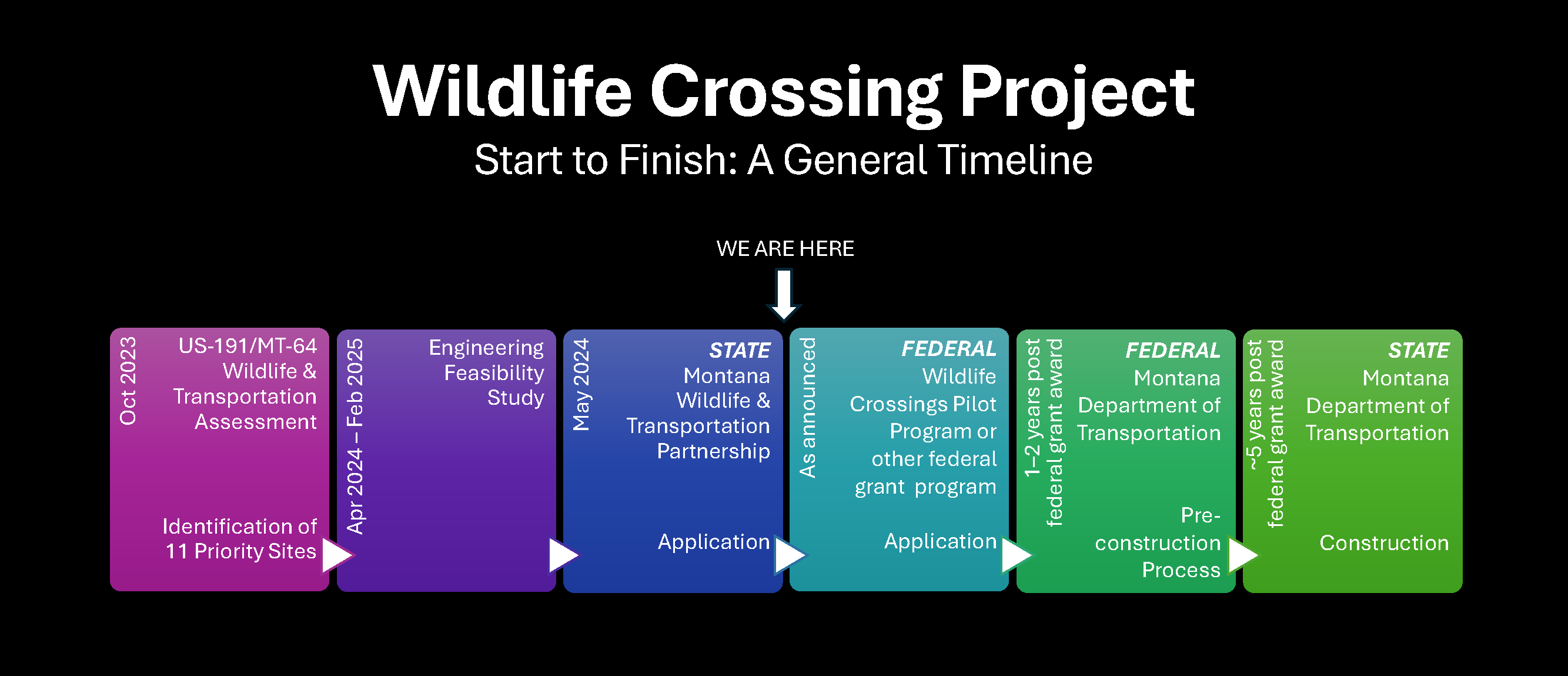
Engineering Feasibility
In order to evaluate the recommendations of the Wildlife & Transportation Assessment for construction, engineering feasibility has to be determined. In 2024, supported by community partners, the Center hired Jacobs, a global engineering leader, to examine wildlife overpasses, underpasses, bridge retrofits, and associated accommodations—including fencing to funnel wildlife to suitable structures—in two priority areas.
Read more about the engineering feasibility studies and what goes into the siting and design of a wildlife crossing.
Other Priority Sites
Based on the support and encouragement of local communities, the Center is working to ensure future infrastructure projects along US-191 and MT-64 are as wildlife-friendly as possible. Together with public agencies, along with research and nonprofit partners, we are reaching out to landowners and providing technical assistance on opportunities to increase safe passage for wildlife and reduce wildlife-vehicle collisions along the length of US-191.
The time is now to ensure wildlife can use habitat freely as our region continues to grow.
 Let’s Keep in Touch!
Let’s Keep in Touch!
Would you like to to receive occasional email updates on the US-191/MT-64 Wildlife & Transportation Assessment and progress toward reducing wildlife-vehicle collisions?
If so, please sign up here! You can unsubscribe at any time.
Presentation
The Center for Large Landscape Conservation presented key findings of the Assessment in Community Information Sessions in Big Sky, Gallatin Gateway, and West Yellowstone, Montana. This video, filmed during the Big Sky session, provides essential background about road ecology and explains the methods used to identify priority sites for potential mitigation.
With Sincere Thanks
We would like to acknowledge the generosity of the following supporters of the US-191/MT-64 Wildlife & Transportation Assessment and the US-191 Wildlife Crossings Project Fund, including matching pledges for an application for federal funding:
Big Sky Real Estate Collective
Big Sky Resort Area District
Cinnabar Foundation
Cromley Messina Foundation
Gallatin Wildlife Association
Greater Yellowstone Coalition
Hey Bear
Langlas & Associates
Christopher Li
Lohss Construction
Lone Mountain Land Company
J. Love Legacy Foundation
Patrick Mitchell
Moonlight Community Foundation
Outlaw Partners
Overland West
Andrew Sabin Family Foundation
Schlauch Bottcher Construction, Inc.
SITKA Gear
TMC, Inc.
Turner Family
Turner Foundation
The Volgenau Foundation
Weeden Foundation
Yellowstone Club Community Foundation
Questions about the Center’s activities along US-191? Please contact us at 191@largelandscapes.org
Banner Photo: The Gallatin River and US-191 near Big Sky, Montana – Adobe Stock; Elk photo: NPS/Jacob W. Frank

